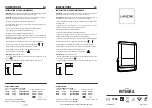
Parts and Repairs
This product does not include spare parts and can not be repaired by the user. Any inspections and overall
repairs or maintenance should be carried out by a specialist only.
Cleaning and Maintenance
Clean the exterior of this device on a monthly basis with a dry, or slightly damp microfibre cloth. Ensure that
the device is unplugged before cleaning.
Check that all screws are intact and secured and tighten or replace them where needed. Check all metal
parts of the device for any signs of corrosion. If corrosion is found, the device needs to be checked
thoroughly.
Power Output
The Compar Kit Jr. is fitted with a power sharing output via an IEC C13 socket so that more than one device
can be connected and fed power as part of a chain without the need for more than one mains power point.
The fuse fitted in this device is intended to protect that single device only. The input and output of the power
supply are directly wired to each other. If any problems occur with the Compar Kit Jr. itself, then this will have
no effect on any chained devices.
Since a standard 230V group can be loaded with a maximum of 16A and the maximum power that can be
processed by an IEC C13 or C14 is set to 10A, any devices connected to the power sharing output can
amount to a maximum or 2,000 Watts. This total includes a small safety margin.
This capacity is usually more than enough to daisy-chain a complete LED lighting set up. Avoid connected
equipment that requires a lot of power like smoke machines or halogen lighting.
Please note: An IEC C13 to IEC C14 power cable with a minimum 1.5 mm² thickness must always be used
since the current this cable can transfer can exceed 3A.
DMX Terminator
When using the device in DMX mode, it is common for a ‘terminator’ to be used at the end of the DMX
circuit. A DMX terminator is a terminal resistor, consisting of a 120 Ohm resistor placed between the second
and third pin to eliminate any data reflections. Data reflections can cause strange behaviour in DMX
controlled devices.
DMX-terminators are sold ready-made but it is possible to solder a 120 Ohm resistor between the second
and third pin of a standard male XLR connector.
The information included in this manual is subject to change at any time and without notice
Version: 1.0
Date and Author Initials: 17-02-2020 RV
Revision Date and Author Initials: -




































